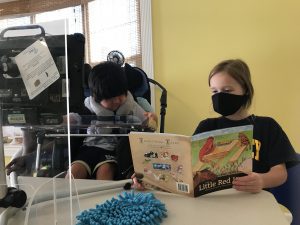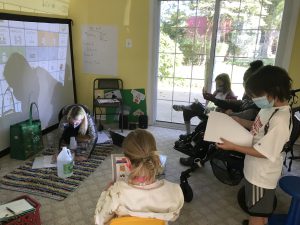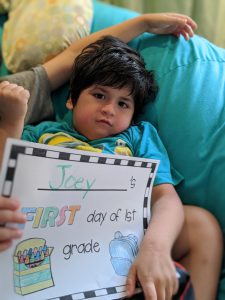 One aspect of our Augmented Learning Study Program is providing small group academic instruction that would be seen in schools. In this time of virtual learning, we want our learners to have an opportunity to learn in groups from each other – as COVID safely as they can.
One aspect of our Augmented Learning Study Program is providing small group academic instruction that would be seen in schools. In this time of virtual learning, we want our learners to have an opportunity to learn in groups from each other – as COVID safely as they can.
One challenge we have worked on is making an inclusive guided reading experience for our first graders who use and do not use devices. As I’ve written about before in teaching Joey to read – it can be extremely tiring for him to read the words on the page and then find them on his device. If we measured his ability to read and comprehend through his output on his device we would continue to see him reading at a beginning kindergarten level. And yet, Joey consistently recognizes many of the words from the dulce list through first grade. He is also able to match sentences from a guided reading text to their picture – demonstrating reading comprehension.
So how do we make that a group activity?

 tle Red Hen. Both of them took the project seriously, analyzing what type of characters we should have, where the play should take place, and what Little Red should cook. I looked across the room to watch the speech pathologist work with Joey and another first grader to use Bitmojis. Joey used his device to describe what should go into the Bitmoji for his friend.
tle Red Hen. Both of them took the project seriously, analyzing what type of characters we should have, where the play should take place, and what Little Red should cook. I looked across the room to watch the speech pathologist work with Joey and another first grader to use Bitmojis. Joey used his device to describe what should go into the Bitmoji for his friend. Our Inclusive AAC Learning Group officially began September 14, 2020. After what somehow felt both like months of planning and yet still not enough time to be ready, we opened our group to a small but eager group of first through third grade students on Monday afternoon. We are looking forward to welcoming more students, but are taking advantage of the small group to find our sea legs and develop our rhythm.
Our Inclusive AAC Learning Group officially began September 14, 2020. After what somehow felt both like months of planning and yet still not enough time to be ready, we opened our group to a small but eager group of first through third grade students on Monday afternoon. We are looking forward to welcoming more students, but are taking advantage of the small group to find our sea legs and develop our rhythm. There are times when dire circumstances lead to the best ingenuity and creativity. After all, isn’t necessity the mother of invention? This fall, Joey’s Foundation is introducing a new inclusive learning opportunity to support Joey and children like him in maintaining their use of AAC despite virtual instruction.
There are times when dire circumstances lead to the best ingenuity and creativity. After all, isn’t necessity the mother of invention? This fall, Joey’s Foundation is introducing a new inclusive learning opportunity to support Joey and children like him in maintaining their use of AAC despite virtual instruction. 
